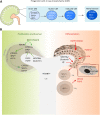Concise Review: Understanding the Renal Progenitor Cell Niche In Vivo to Recapitulate Nephrogenesis In Vitro
- PMID: 26494782
- PMCID: PMC4675508
- DOI: 10.5966/sctm.2015-0104
Concise Review: Understanding the Renal Progenitor Cell Niche In Vivo to Recapitulate Nephrogenesis In Vitro
Abstract
Chronic kidney disease (CKD), defined as progressive kidney damage and a reduction of the glomerular filtration rate, can progress to end-stage renal failure (CKD5), in which kidney function is completely lost. CKD5 requires dialysis or kidney transplantation, which is limited by the shortage of donor organs. The incidence of CKD5 is increasing annually in the Western world, stimulating an urgent need for new therapies to repair injured kidneys. Many efforts are directed toward regenerative medicine, in particular using stem cells to replace nephrons lost during progression to CKD5. In the present review, we provide an overview of the native nephrogenic niche, describing the complex signals that allow survival and maintenance of undifferentiated renal stem/progenitor cells and the stimuli that promote differentiation. Recapitulating in vitro what normally happens in vivo will be beneficial to guide amplification and direct differentiation of stem cells toward functional renal cells for nephron regeneration.
Significance: Kidneys perform a plethora of functions essential for life. When their main effector, the nephron, is irreversibly compromised, the only therapeutic choices available are artificial replacement (dialysis) or renal transplantation. Research focusing on alternative treatments includes the use of stem cells. These are immature cells with the potential to mature into renal cells, which could be used to regenerate the kidney. To achieve this aim, many problems must be overcome, such as where to take these cells from, how to obtain enough cells to deliver to patients, and, finally, how to mature stem cells into the cell types normally present in the kidney. In the present report, these questions are discussed. By knowing the factors directing the proliferation and differentiation of renal stem cells normally present in developing kidney, this knowledge can applied to other types of stem cells in the laboratory and use them in the clinic as therapy for the kidney.
Keywords: Differentiation; Embryonic stem cells; Induced pluripotent stem cells; Kidney; Progenitor cells; Self-renewal; Stem cell culture; Stem/progenitor cell.
©AlphaMed Press.
Figures


Similar articles
-
Renal lineage cells as a source for renal regeneration.Pediatr Res. 2018 Jan;83(1-2):267-274. doi: 10.1038/pr.2017.255. Epub 2017 Nov 15. Pediatr Res. 2018. PMID: 28985199 Review.
-
Generation of interspecies limited chimeric nephrons using a conditional nephron progenitor cell replacement system.Nat Commun. 2017 Nov 23;8(1):1719. doi: 10.1038/s41467-017-01922-5. Nat Commun. 2017. PMID: 29170512 Free PMC article.
-
Prolonging nephrogenesis in preterm infants: a new approach for prevention of kidney disease in adulthood?Iran J Kidney Dis. 2015 May;9(3):180-5. Iran J Kidney Dis. 2015. PMID: 25957420 Review.
-
Concise Review: Kidney Generation with Human Pluripotent Stem Cells.Stem Cells. 2017 Nov;35(11):2209-2217. doi: 10.1002/stem.2699. Epub 2017 Sep 26. Stem Cells. 2017. PMID: 28869686 Free PMC article. Review.
-
Epigenetic States of nephron progenitors and epithelial differentiation.J Cell Biochem. 2015 Jun;116(6):893-902. doi: 10.1002/jcb.25048. J Cell Biochem. 2015. PMID: 25560433 Free PMC article. Review.
Cited by
-
RNA interference therapeutics targeting angiotensinogen ameliorate preeclamptic phenotype in rodent models.J Clin Invest. 2020 Jun 1;130(6):2928-2942. doi: 10.1172/JCI99417. J Clin Invest. 2020. PMID: 32338644 Free PMC article. No abstract available.
-
Isolation, Culture and Comprehensive Characterization of Biological Properties of Human Urine-Derived Stem Cells.Int J Mol Sci. 2021 Nov 19;22(22):12503. doi: 10.3390/ijms222212503. Int J Mol Sci. 2021. PMID: 34830384 Free PMC article.
-
Cancer Stem Cells in Renal Cell Carcinoma: Origins and Biomarkers.Int J Mol Sci. 2023 Aug 24;24(17):13179. doi: 10.3390/ijms241713179. Int J Mol Sci. 2023. PMID: 37685983 Free PMC article. Review.
-
Disruption of mitochondrial complex III in cap mesenchyme but not in ureteric progenitors results in defective nephrogenesis associated with amino acid deficiency.Kidney Int. 2022 Jul;102(1):108-120. doi: 10.1016/j.kint.2022.02.030. Epub 2022 Mar 24. Kidney Int. 2022. PMID: 35341793 Free PMC article.
References
-
- Bertram JF, Douglas-Denton RN, Diouf B, et al. Human nephron number: Implications for health and disease. Pediatr Nephrol. 2011;26:1529–1533. - PubMed
-
- Puelles VG, Hoy WE, Hughson MD, et al. Glomerular number and size variability and risk for kidney disease. Curr Opin Nephrol Hypertens. 2011;20:7–15. - PubMed
-
- Williams J, Phillips A. Structure and function of the kidney. Oxford, U.K.: Oxford University Press; 2003. pp. 195–202.
-
- Inker LA, Astor BC, Fox CH, et al. KDOQI US commentary on the 2012 KDIGO clinical practice guideline for the evaluation and management of CKD. Am J Kidney Dis. 2014;63:713–735. - PubMed
Publication types
MeSH terms
LinkOut - more resources
Full Text Sources
Other Literature Sources
Medical

